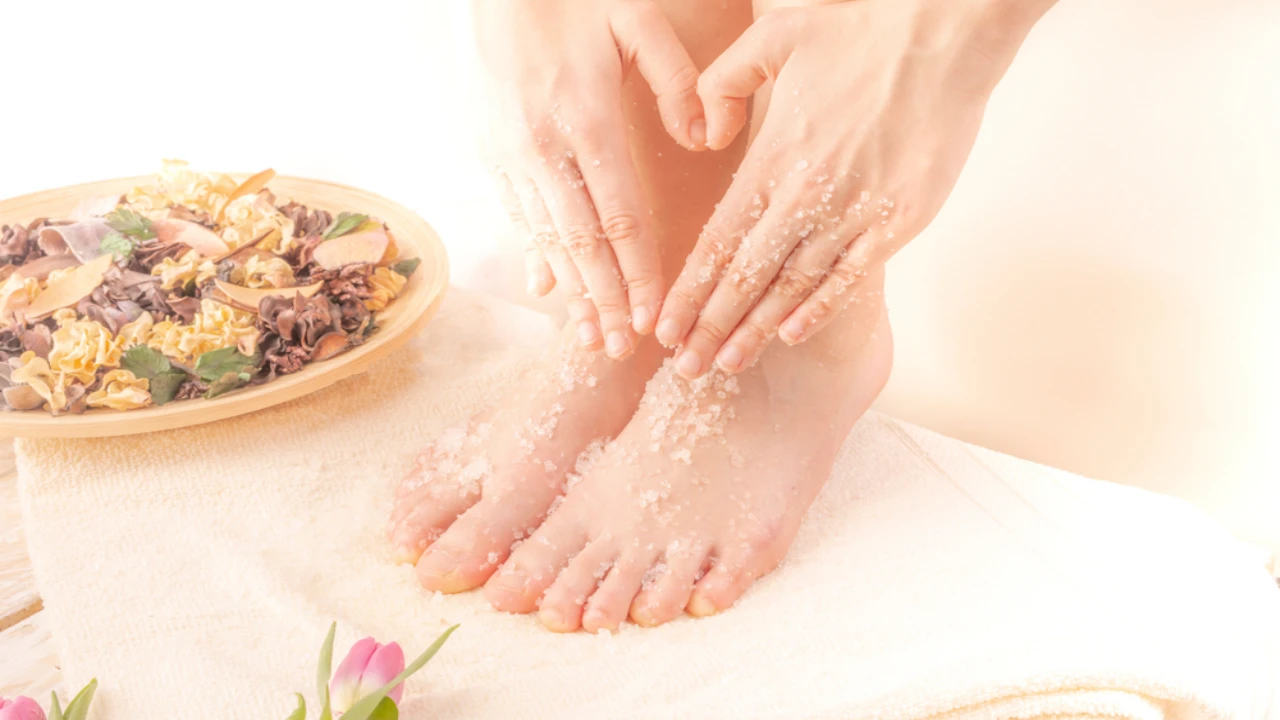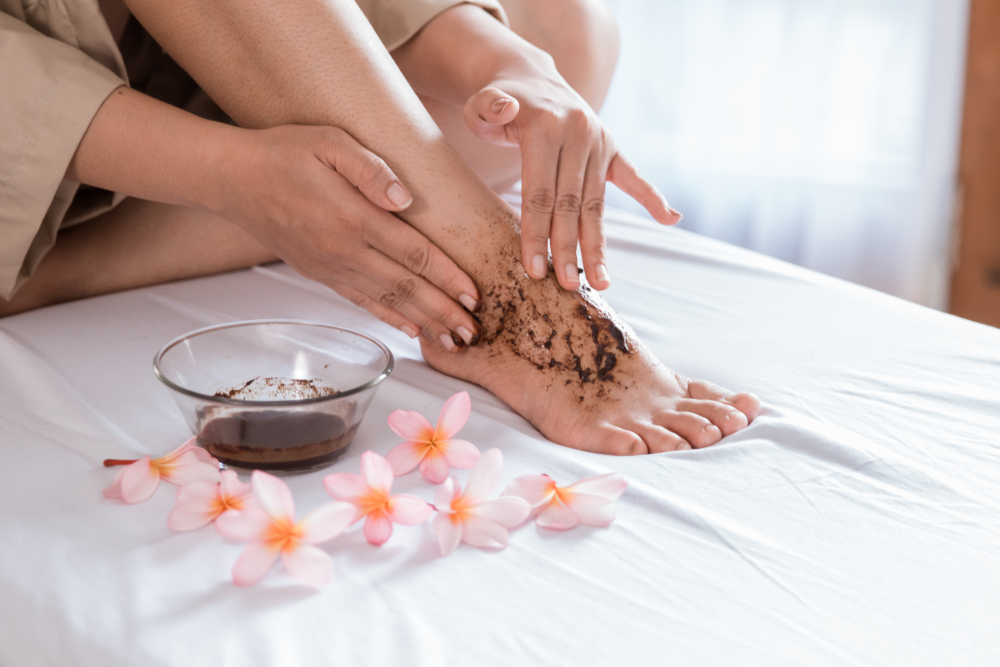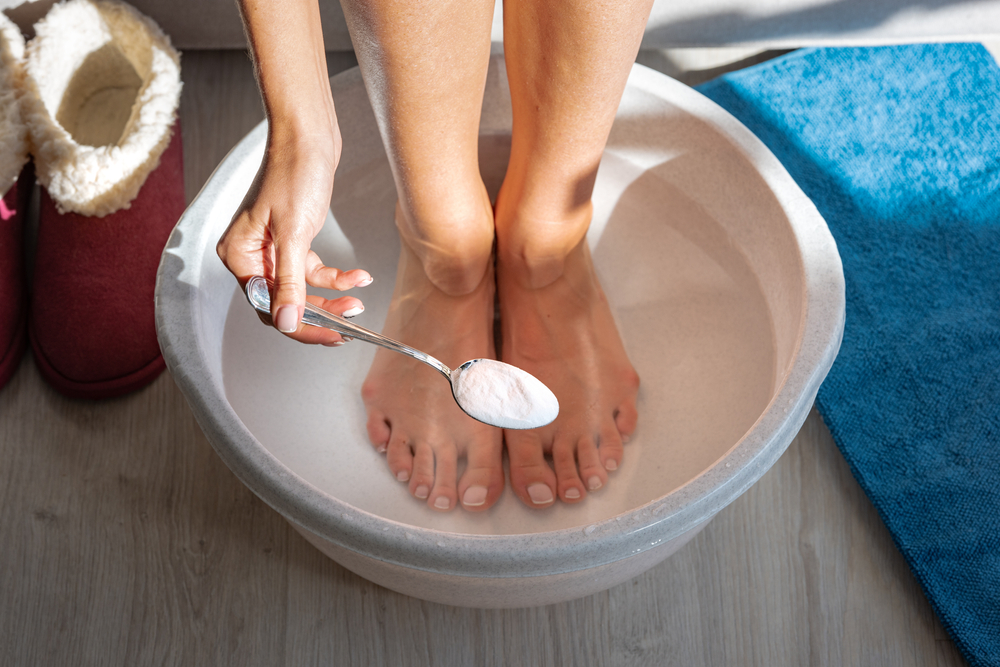DIY Foot Scrubs: 10 Amazing Recipes to Nourish Your Feet
Your feet deserve a luxurious treatment after all they go through. Try these amazing DIY foot scrubs to transform your feet from dull to dazzling at home.

It is time for your tired feet to find solace and rejuvenate. The joy of sinking into luxurious DIY foot scrubs after a long day is relaxing! But here's the thing; our hardworking feet often bear the brunt of our busy lives, leaving them in desperate need of some pampering. Cracked heels, dry skin, and rough patches are quite familiar. Constant exposure to harsh weather conditions, walking or standing for extended periods, and neglecting proper foot care can all contribute to these pesky problems. But fear not, for there is a perfect solution to bring those soles back to life!
DIY foot scrubs are your ticket to soft and pampered feet. By harnessing the power of natural ingredients and a dash of creativity, these homemade concoctions can transform your foot care routine into a delightful and invigorating experience. Say goodbye to calluses and enjoy smooth feet. With the wide range of foot scrub recipes in this article, you can customize your foot care regimen to suit your needs. From refreshing peppermint-infused scrubs that cool and invigorate, to nourishing coconut oil blends that deeply moisturize, the possibilities are endless. No more hiding those feet away in embarrassment; it's time to let them shine!
So, grab your mixing bowls, gather your favorite ingredients, and mix all the goodness to form a foot scrub for dead skin. Get ready to put your best foot forward and step into the world.
Benefits of Using DIY Foot Scrubs

The benefits are numerous; all it takes is for you to spare a little time to pamper yourself with homemade foot scrubs.
1. Exfoliation
Foot scrubs help remove dead skin cells and rough patches from your feet, resulting in smoother and softer skin. By gently exfoliating the surface, scrubs promote cell renewal and reveal healthier-looking skin. It also prevents callus buildup, which is caused by the accumulation of dead skin, and keeps foot infections at bay (1).
2. Improved Circulation
The massaging action of using a foot scrub with essential oil stimulates blood flow to your feet, promoting better circulation. This can help reduce swelling, relieve fatigue, and enhance overall foot health (2).
3. Callus And Corn Removal
Foot scrubs work wonders in reducing the appearance of calluses and corns, which can be uncomfortable and unsightly. The exfoliating properties of foot scrubs help to gradually diminish these hardened areas, leaving your feet feeling smoother and more comfortable (3).
4. Deep Moisturization
DIY foot scrubs contain nourishing ingredients such as oils, butter, and moisturizers. These ingredients help to hydrate and nourish your skin, combating dryness and keeping your feet supple and moisturized (4).
5. Relaxation And Stress Relief
Treating your feet with a foot scrub with essential oils can provide a much-needed moment of relaxation and stress relief. The soothing sensation of massaging the scrub onto your feet can help ease tension and promote a calming effect. (5).
6. Foot Odor Control
Foot scrubs can help combat unpleasant foot odor by removing dead skin cells and eliminating bacteria that contribute to the odor. The fresh and clean feeling after using a foot scrub can leave your feet smelling pleasant and revitalized.
Remember, regular use of foot scrub, combined with proper foot care, can lead to healthier, more attractive feet. So, treat yourself to the benefits of using a foot scrub and step confidently towards happy and pampered feet!
10 Homemade DIY Foot Scrubs You Can Try
You surely do not want smelly feet because your feet contain about 250k sweat glands, which are capable of producing around 250 ml of perspiration each day! Admittedly, getting pedicures every now and then is expensive and also does not help with heel aches. DIY foot scrubs are another way to let your feet skin breathe and keep the pain at bay. Try one of these and see how it helps you regain a smooth and ache-free heel.
1. Peppermint And Epsom Salt
Ingredients
- ½ cup of Epsom salt
- ¼ cup of coconut oil
- 10 drops of peppermint essential oil
Instructions
- In a bowl, mix all the ingredients vigorously until well combined.
- Add peppermint essential oil and mix again.
- Apply the scrub to your feet, focusing on dry or rough areas.
- Gently massage in circular motions for a few minutes.
- Now add the remaining scrub into a tub of warm water.
- Let your feet soak in the water for 30-60 minutes.
- Rinse off with warm water and pat dry.
- Moisturize your skin thoroughly after removing it.
Why This Works
Epsom salt, or magnesium sulfate, is commonly used in foot soaks for its soothing and relaxing properties. Epsom salt, when dissolved, promotes muscle relaxation and relieves aches and foot pain. Although there is not much evidence, promoters of Epsom salt say it has anti-inflammatory properties and helps reduce discomfort caused by edema (6).
While peppermint provides a cooling sensation, the menthol in peppermint is believed to possess antibacterial and antifungal properties (7). Consequently, using peppermint in a foot scrub may help combat odor-causing bacteria and fungi on the feet. Furthermore, peppermint oil is thought to improve blood circulation by dilating blood vessels when applied topically (8).
Cynthia Hamilton, a health and wellness coach at YOGI TIMES, and a lifestyle guide says, “I personally like peppermint foot scrubs made from peppermint oil, which helps you feel refreshed, and relaxed. It has such a refreshing smell along with antibacterial properties, which help fight odor caused by different bacteria in the foot. Foot scrub with ingredients like pumice and jojoba beads can also help with sweaty feet.”
2. Honey And Brown Sugar
Ingredients
- ¼ cup of brown sugar
- 2 tablespoons of honey
- 2 tablespoons of olive oil
Instructions
- Combine brown sugar, honey, and olive oil in a bowl.
- Mix until you have a thick, grainy paste.
- Apply the scrub to your feet, massaging it using circular motions.
- Pay extra attention to areas with calluses or rough patches.
- Rinse off with warm water and pat dry.
Why This Works
The moisturizing properties of honey help you exfoliate gently without leaving a dry effect. Its natural antibacterial properties may also help prevent bacterial growth on the feet, potentially reducing odor and the risk of infections (9).
While brown sugar helps remove all the dead skin cells, when combined with honey, it creates a gentle scrub that can effectively remove dead skin cells and improve the overall texture of your feet. As you massage the scrub onto your feet, brown sugar helps to slough off rough patches and reveal healthier skin underneath. This exfoliation process can leave your feet feeling rejuvenated.
3. Coffee And Coconut Oil
Ingredients
- ½ cup used coffee grounds
- ¼ cup of coconut oil
- 2 tablespoons of granulated sugar
Instructions
- Mix coffee grounds, coconut oil, and granulated sugar in a bowl.
- Stir well until the ingredients are thoroughly combined.
- Apply the scrub to your feet and gently scrub in a circular motion.
- Focus on areas that need exfoliation, such as the heels or the balls of your feet.
- You can let it sit for 30-40 minutes as it also helps with tanning.
- Rinse off with warm water and pat dry.
Why This Works
A coffee person would never say no to the smell of freshly brewed coffee. Well, this does not contain exactly freshly brewed coffee, but just powdered ground coffee. Coffee’s antimicrobial, antiaging, and skin-tightening properties help you deal with any infection down there. The coffee grounds are a gentle exfoliator, and the aroma has an invigorating effect on your senses (10).
Coconut oil is a natural moisturizer that can help hydrate and nourish the skin. When combined with coffee grounds in a foot scrub, coconut oil can provide added benefits. Its moisturizing properties can help combat dryness and keep your feet feeling smooth and supple. It is also known for its antimicrobial properties, which may help reduce the presence of bacteria or fungi on the feet, potentially minimizing foot odor and the risk of infections (11).
4. Oatmeal And Yogurt
Ingredients
- 1/4th cup of oatmeal
- 2 tablespoons of plain yogurt
- 1 tablespoon of honey
Instructions
- Grind the oatmeal into a fine powder using a blender or food processor.
- In a bowl, mix the oatmeal powder, yogurt, and honey until well combined.
- Apply the scrub to your feet, gently massaging it in.
- Allow the scrub to sit on your feet for 10-15 minutes.
- Rinse off with warm water and pat dry.
Why This Works
Apart from being a great morning breakfast, oatmeal also comes out to be a perfect evening pedicure. Oatmeal acts as a perfect exfoliant. It contains saponins, which are natural cleansing agents and help remove dirt, impurities, and excess oil. By using an oatmeal and yogurt foot scrub, you can effectively cleanse your feet, preventing bacterial and fungal infections and promoting overall foot health (12).
Yogurt, on the other hand, is known for its moisturizing and nourishing properties. It contains lactic acid, which helps to gently exfoliate and soften the skin (13).
The combination of oatmeal and yogurt in a foot scrub creates a potent blend that not only exfoliates and moisturizes but also soothes and calms the skin. This can be particularly beneficial for individuals with dry or sensitive skin, as it helps to alleviate itchiness, redness, and inflammation.
5. Lemon And Sea Salt
Ingredients
- Juice of 1 lemon
- ½ cup of sea salt
- 2 tablespoons of almond oil
Instructions
In a bowl, combine lemon juice, sea salt, and almond oil.
- Mix until you have a paste-like consistency.
- Apply the scrub to your feet, massaging it using circular motions.
- Concentrate on areas with rough skin or calluses.
- Rinse off with warm water and pat dry.
Why This Works
Combining the brightening and cleansing properties of lemon with the exfoliating action of sea salt creates a powerful scrub that can leave your feet feeling renewed and revitalized. Lemon contains natural acids, particularly citric acid, which acts as a gentle exfoliant. When used in a foot scrub, it helps to slough off dead skin cells. The astringent properties it has may help tighten the skin and reduce excess oiliness (??14).
This can be especially beneficial for individuals who have sweaty feet or are prone to foot odor. Its antimicrobial properties can help combat bacteria and fungus on the feet, reducing the risk of infections (15).
6. Essential Oil And Ginger
Ingredients
- ½ cup of freshly ground ginger
- Few drops of essential oil of choice, lemongrass or lemon
- 1 tablespoon of carrier oil
Instructions
- Add freshly chopped ginger to a bowl of boiling water
- Once it comes to a boil, filter out the water and add a few drops of essential oil and carrier oil to the chopped ginger and the boiling water to make a paste-like consistency.
- Apply the scrub to the legs in a circular motion.
- Let the scrub sit for 30 minutes, then wash it with lukewarm water.
Why This Works
Ginger has natural warming and stimulating properties, which can help increase blood flow when used in a foot scrub. Improved circulation in the feet can have multiple benefits, such as reducing swelling and inflammation, relieving muscle soreness, and promoting overall foot health.
The addition of essential oils further enhances the benefits of the foot scrub. Essential oils like peppermint, lavender, or tea tree can provide various therapeutic effects. Tea tree oil, with its antimicrobial properties, can help combat bacteria and fungus on the feet, preventing infections and foot odor (2).
Regular use of ginger and essential oil foot scrub can also promote foot hygiene by cleansing the feet and preventing bacterial and fungal infections.
7. Aloe Vera And Brown Sugar
Ingredients
- ¼ cup of brown sugar
- 2 tablespoons of aloe vera gel
- 1 tablespoon of coconut oil
Instructions
- Mix brown sugar, aloe vera gel, and coconut oil in a bowl.
- Stir until you have a grainy paste.
- Apply the scrub to your feet, massaging it in gently.
- Allow the scrub to sit on your feet for a few minutes.
- Rinse off with warm water and pat dry.
Why This Works
The soothing and healing effects of aloe vera make it a complete package of goodness. It has anti-inflammatory properties that provide relief from dryness, itching, and irritation (16).
Brown sugar acts as a gentle exfoliant, helping to remove dead skin cells and rough patches from the surface of your feet, as mentioned above.
8. Shea Butter, Sugar, And Vitamin E

Ingredients
- 1/2 cup of shea butter
- 2 tablespoons of vitamin E oil
- 1 cup of granulated sugar
- 1/4 cup of olive oil or coconut oil
- Optional: 10-15 drops of essential oil (such as peppermint or lavender) for fragrance
Instructions
- In a microwave-safe bowl, melt the shea butter. You can do this by heating it in short bursts of 10-15 seconds in the microwave until it is completely melted.
- Alternatively, you can melt it in a double boiler on the stovetop. Put shea butter in a bowl and put it over the bowl of boiling water. This will avoid the shea butter to burn.
- Once the shea butter is melted, add the vitamin E oil and mix well to combine.
- In a separate bowl, combine the granulated sugar and the olive oil (or coconut oil) and stir until it forms a thick paste.
- Pour the melted shea butter and vitamin E mixture into the bowl with the sugar and oil mixture. Stir well until all the ingredients are thoroughly combined.
- Add 10-15 drops of your preferred essential oil for fragrance if desired. Mix well.
- Transfer the foot scrub into an airtight container for storage.
- To use the foot scrub, wet your feet and apply a small amount to your foot, and gently massage it in circular motions, focusing on rough areas such as heels and soles. Continue massaging for a few minutes to exfoliate the skin.
- Rinse your feet with warm water and pat them dry with a towel.
- Apply a moisturizer or foot cream to keep your feet hydrated after using the scrub.
Why This Works
The sugar in the foot scrub acts as an exfoliant, helping to remove dead skin cells and rough patches on your feet. Shea butter is well-known for its excellent moisturizing properties. As a foot scrub, it hydrates and nourishes the skin on your feet, keeping them moisturized and preventing dryness and cracking (17).
Furthermore, the foot scrub's inclusion of vitamin E may promote wound healing and repair damaged skin. Vitamin E is a powerful antioxidant that protects your heel from infections (18). The combination of shea butter, sugar, and vitamin E in a foot scrub can also help soften calluses and rough areas on the feet, making them smoother and more supple.
9. Honey, Bentonite Clay, And Epsom Salt
Ingredients
- 2 tablespoons of bentonite clay
- 2 tablespoons of apple cider vinegar
- 1/2 cup of Epsom salt
Instructions
- In a mixing bowl, combine the Epsom salt and bentonite clay. Stir them together until they are well mixed.
- Add the honey to the mixture and stir again.
- Add a few drops of your preferred essential oil for fragrance if desired. Essential oils like lavender, peppermint, or tea tree oil work well for foot scrubs.
- Next, pour in the carrier oil of your choice. This oil will help bind the ingredients together and provide additional moisturizing benefits.
- Mix all the ingredients together until you have a thick, consistent scrub. If the mixture seems too dry, you can add a little more carrier oil or honey to achieve the desired texture.
- Once the scrub is ready, you can use it immediately. Take a small amount of the mixture and gently massage it onto your feet, focusing on rough areas like the heels and soles. Scrub in circular motions for a few minutes to exfoliate and remove dead skin cells.
- After scrubbing, rinse your feet with warm water and pat them dry with a towel. You should notice smoother, softer feet.
Why This Works
A foot scrub made with honey, bentonite clay, and Epsom salt can offer several benefits for your feet. Firstly, the salt helps to remove dead skin cells and reveal fresh, healthier skin. Bentonite clay is known for its ability to draw out impurities and toxins from the skin. When applied to your feet, it can help remove any buildup or residue, leaving them feeling refreshed and rejuvenated (19).
Hydration is another benefit provided by this foot scrub. Honey, a natural humectant, helps retain moisture in the skin (9). Epsom salt is rich in magnesium, which is associated with stress relief and relaxation (6). The foot scrub's ingredients also offer anti-inflammatory effects. Both bentonite clay and Epsom salt possess anti-inflammatory properties.
10. Baking Soda Foot Scrub

Ingredients
- 1/4 cup of baking soda
- 3 tablespoons of warm water
- 1 tablespoon of olive oil or coconut oil (optional)
- A few drops of essential oil (such as lavender or peppermint) for fragrance (optional)
Instructions
- Mix baking soda and warm water. Mix well until you form a thick paste. If desired, you can add olive oil or coconut oil to the mixture for added moisturizing benefits.
- You may add a few drops of essential oil to the mixture for a pleasant scent and additional relaxation benefits if it is available.
- Before using the foot scrub, soak your feet in warm water for 10-15 minutes to soften the skin.
- Once your feet are soaked, take a small amount of the baking soda scrub and apply it to one foot, focusing on rough areas like heels and calluses. Gently massage the scrub onto your foot using circular motions for a few minutes.
- Repeat the same process on the other foot.
- After scrubbing, rinse them thoroughly with warm water to remove any residue.
- Pat your feet dry with a clean towel and apply a moisturizer to keep them soft and hydrated.
Note: It's important to note that while baking soda is generally safe to use on the skin, some people may be sensitive to or allergic to it. Hence, always do a patch test before application.
Why This Works
A baking soda foot scrub is a natural and effective way to exfoliate and cleanse your feet, leaving them feeling soft and refreshed. Baking soda, also known as sodium bicarbonate, has gentle exfoliating properties and antifungal properties that help deal with any infections and remove the top layer of skin cells. (20).
Conclusion
An achy foot or cracked heel—both can be equally disturbing; all you need is a gentle, relaxing DIY foot scrub. Exfoliating and soaking your feet is the perfect way to calm your nerves and improve blood circulation. It all starts with some simple kitchen staples from your pantry. This can be as easy as lemon, baking soda, or honey. While a weekly pedicure can cost you a fortune, these homemade DIY scrubs would hardly cost you a dollar. Additionally, you can do it once a week for free! Literally.
Your feet carry all the stress of your body; however, they are still mostly ignored and cared less about. By incorporating them into your self-care routine, you can give your feet the attention they deserve, leaving them revitalized and ready to take on the world. It is recommended to be mindful while using any new product on the skin for the first time. If you have specific foot conditions or concerns, it's advisable to consult a healthcare professional before trying a DIY foot scrub.
Contributor: Cynthia Hamilton, Health and Wellness Coach, YOGI TIMES
Sources:
1. (PDF) Skin Care with Herbal Exfoliants
https://www.researchgate.net/publication/224892687_Skin_Care_with_Herbal_Exfoliants
2. Essential oils used in aromatherapy: A systemic review - ScienceDirect
https://www.sciencedirect.com/science/article/pii/S2221169115001033
3. Corns
https://www.ncbi.nlm.nih.gov/books/NBK470374/
4. The Role of Moisturizers in Addressing Various Kinds of Dermatitis: A Review - PMC
https://www.ncbi.nlm.nih.gov/pmc/articles/PMC5849435/
5. Using aromatherapy in the clinical setting: Making sense of scents
https://www.americannursetoday.com/aromatherapy-clinical-setting/
5. The Effect of Warm Footbath With Salt of Edema Under Extremity In Postpartum Pre Eclamsia
6. Evaluation of essential oil obtained from Mentha× piperita L. against multidrug-resistant strains
https://pubmed.ncbi.nlm.nih.gov/31686869/
7. Topical menthol increases cutaneous blood flow
https://pubmed.ncbi.nlm.nih.gov/27131832/
8. Honey in dermatology and skin care: a review
https://pubmed.ncbi.nlm.nih.gov/24305429/
9. Antioxidant and Antiradical Activity of Coffee - PMC
https://www.ncbi.nlm.nih.gov/pmc/articles/PMC4665516/
10. Effect of mineral oil, sunflower oil, and coconut oil on prevention of hair damage. | Semantic Scholar
11. Colloidal oatmeal: history, chemistry and clinical properties
https://pubmed.ncbi.nlm.nih.gov/17373175/
12. Systemic skin whitening/lightening agents: What is the evidence?
13. (PDF) Lemon as a source of functional and medicinal ingredient: A review
14. Vitamin C in dermatology - PMC
https://www.ncbi.nlm.nih.gov/pmc/articles/PMC3673383/
15. ALOE VERA: A SHORT REVIEW - PMC
https://www.ncbi.nlm.nih.gov/pmc/articles/PMC2763764/
16. Anti-Inflammatory and Skin Barrier Repair Effects of Topical Application of Some Plant Oils
https://www.ncbi.nlm.nih.gov/pmc/articles/PMC5796020/
17. Vitamin E and wound healing: an evidence?based review
https://onlinelibrary.wiley.com/doi/full/10.1111/iwj.12295
18. Bentonite, Bandaids, and Borborygmi - PMC
https://www.ncbi.nlm.nih.gov/pmc/articles/PMC2895274/
19. Antifungal activity of sodium bicarbonate against fungal agents causing superficial infections
https://pubmed.ncbi.nlm.nih.gov/22991095/
20. Antifungal activity of sodium bicarbonate against fungal agents causing superficial infections





 JOIN OUR WHATSAPP CHANNEL
JOIN OUR WHATSAPP CHANNEL






















































